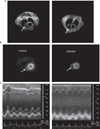Advances in imaging of animal models of Chagas disease
- PMID: 21820557
- PMCID: PMC3556243
- DOI: 10.1016/B978-0-12-385863-4.00009-5
Advances in imaging of animal models of Chagas disease
Abstract
Since serial studies of patients are limited, researchers interested in Chagas disease have relied on animal models of Trypanosoma cruzi infection to explore many aspects of this important human disease. These studies have been important for evaluation of the immunology, pathology, physiology and other aspects of pathogenesis. While larger animals have been employed, mice have remained the most favoured animal model, as they recapitulate many aspects of the human disease, are easy to manipulate genetically and are amenable to study by small animal imaging technologies. Further, developments in non-invasive imaging technologies have permitted the study of the same animal over an extended period of time by multiple imaging modalities, thus permitting the study of the transition from acute infection through the chronic stage and during therapeutic regimens.
Copyright © 2011 Elsevier Ltd. All rights reserved.
Figures




Similar articles
-
[Chagas' disease in dogs experimentally infected with Trypanosoma cruzi].Medicina (B Aires). 1986;46(2):195-200. Medicina (B Aires). 1986. PMID: 3106745 Spanish. No abstract available.
-
Chagas disease--What the cardiac surgeon needs to know.J Card Surg. 2018 Oct;33(10):603. doi: 10.1111/jocs.13796. Epub 2018 Jul 29. J Card Surg. 2018. PMID: 30175426 No abstract available.
-
Chagas' disease.Clin Microbiol Rev. 1992 Oct;5(4):400-19. doi: 10.1128/CMR.5.4.400. Clin Microbiol Rev. 1992. PMID: 1423218 Free PMC article. Review.
-
Chronic Chagas' disease in rhesus monkeys (Macaca mulatta): evaluation of parasitemia, serology, electrocardiography, echocardiography, and radiology.Am J Trop Med Hyg. 2003 Jun;68(6):683-91. Am J Trop Med Hyg. 2003. PMID: 12887027
-
Trypanosoma cruzi-induced molecular mimicry and Chagas' disease.Curr Top Microbiol Immunol. 2005;296:89-123. doi: 10.1007/3-540-30791-5_6. Curr Top Microbiol Immunol. 2005. PMID: 16323421 Review.
Cited by
-
Imaging of small-animal models of infectious diseases.Am J Pathol. 2013 Feb;182(2):296-304. doi: 10.1016/j.ajpath.2012.09.026. Epub 2012 Nov 28. Am J Pathol. 2013. PMID: 23201133 Free PMC article. Review.
-
Diet Alters Serum Metabolomic Profiling in the Mouse Model of Chronic Chagas Cardiomyopathy.Dis Markers. 2019 Dec 20;2019:4956016. doi: 10.1155/2019/4956016. eCollection 2019. Dis Markers. 2019. PMID: 31949545 Free PMC article.
-
Lower urinary tract dysfunction in chronic Chagas disease: clinical and urodynamic presentation.World J Urol. 2019 Jul;37(7):1395-1402. doi: 10.1007/s00345-018-2512-3. Epub 2018 Oct 9. World J Urol. 2019. PMID: 30302592 Free PMC article.
-
Prospective study of ventricular function and myocardial deformation related to survival in acute Chagas disease: an experimental animal model.Rev Inst Med Trop Sao Paulo. 2021 Aug 6;63:e61. doi: 10.1590/S1678-9946202163061. eCollection 2021. Rev Inst Med Trop Sao Paulo. 2021. PMID: 34378764 Free PMC article.
-
Electrolyzed Oxidizing Water Modulates the Immune Response in BALB/c Mice Experimentally Infected with Trypanosoma cruzi.Pathogens. 2020 Nov 23;9(11):974. doi: 10.3390/pathogens9110974. Pathogens. 2020. PMID: 33238401 Free PMC article.
References
Publication types
MeSH terms
Grants and funding
LinkOut - more resources
Full Text Sources
Medical

